 |
|||||||||||||||
| At the time of the War of Independence, Nafplion-- with its two almost impregnable fortresses, Acronafplia and Palamedi -- was considered by the Turks to be one of the most powerful strongholds in the Peloponnesus. After over a year of siege, however, Greek insurgents succeeded in wrestling the heavily fortified town from the Turks, later establishing it as the first capital of liberated Greece. |
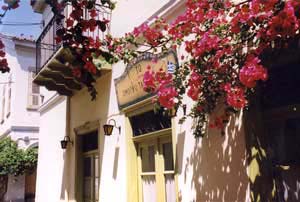 |
||||||||||||||
| Today the city that served as the Greek seat of government from 1829 to 1834 is better known as an idyllic holiday resort, a quiet seaside retreat whose charming lay-out and beautiful location on thenorth slopes of a small rocky peninsula make it one of the most picturesque towns in Greece. But the graceful, winding streets so attractive to tourists also reveal the town's rich and varied history-- a history brought to life by the Venetian buildings, Neoclassical houses, Byzantine churches, and Turkish mosques preserved throughout the city. |
|||||||||||||||
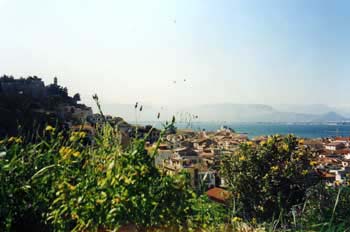 |
|||||||||||||||
| As suggested by its name, Nafplion was probably the naval station for Argos in Mycenaean times-- though mythology offers a more glamorous explanation for its name. According to legend, the city was founded by Nafplios, son of Poseidon, and his son Palamedes, who is said to have invented dice, chess, and other board games to amuse his fellow Greeks during the Trojan War. |
|||||||||||||||
| Though abandoned during Roman times, Nafplion was later repopulated and fortified during the Byzantine period, remaining under Byzantine control until seized by the Franks in 1210-- the first conquest in what would become a tumultuous six hundred year cycle of capture and capitulation at foreign hands. In 1388, Nafplion was taken by the Venetians, who called it Napoli de Romanie and fortified it so securely that it resisted repeated Turkish attacks until finally handed over to the sultan in a peace treaty in 1540. Except for a brief period of recovery by the Venetians (1688-1715)-- during which time the Palamedi fortress was built-- Nafplion remained under Turkish domination until won over by Greece during the Revolution. |
|||||||||||||||
| Although no longer politically prominent as it was during and immediately after the War, present-day Nafplion offers a fascinating historical record of the early days of newly independent Greece. In the center of town, for example, visitors can see the Vouleftiko, the building which housed the first Greek parliament, and the first high school founded in liberated Greece. In the lower part of town, one encounters the church of Agios Spiridon, where Kapodistrias was assassinated in 1831. | |||||||||||||||
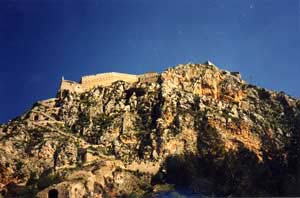 |
|||||||||||||||
| The bullet hole is still visible in the church walls, and the fountain behind which his assassins hid is still standing across the street-- testaments to the darker side of history. What makes Nafplion particularly intriguing to the historically-minded traveller is the way in which the many layers of its past are preserved in juxtaposition-- modern next to ancient, Byzantine mixed with the traces of Frankish, Venetian, and Turkish conquerors-- one stratum of history built on to another. |
|||||||||||||||
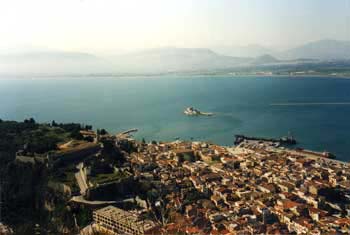 |
|||||||||||||||
So, for example, after visiting the Vouleftiko (itself a converted mosque), you can go next door to an elegant Venetian building that houses the Archaeological Museum and admire pottery fragments and terra cotta figurines from the early Neolithic and Mycenaean periods. Then if you follow the little alleyways to the left of the museum you will find yourself at the foot of the Acronafplia citadel, where a fortress has existed since ancient times, the original walls serving as a foundation for successive rebuildings by Byzantines, Franks, and Venetians. Towering over the city as a whole is the imposing Palamedi fortress, the Venetian stronghold built on the summit of a lofty rock commanding a spectacular view of the gulf of Argolis and surrounding mountains. Palamedi can be reached by an arduous climb up 999 steps-- a climb richly rewarded by breathtaking panoramic views the whole way up-- or, less strenuously, by a 2 mile tourist road on the south side, which runs through the suburb of Pronia, where the Greek National Assembly approved the selection of King Otto of Bavaria in 1832. Situated at the head of the gulf of Argolis, Nafplion's location makes it an ideal base from which to take excursions to Mycenae and Epidavros and other nearby historical attractions. But Nafplion itself will give you plenty to see, and even after you have visited its major sites, the charm of its meandering little streets and alleyways will probably entice you to stay and explore. |
|||||||||||||||
| When you're tired of strolling about the town and its elegant harbor area, stop at one of the many cafes by the water to rest your feet and feast your eyes on postcard-perfect views of the sea and distant mountains. (Just offshore you will also see the small islet of Bourtzi, fortified with a 15th century castle of its own.) Sip your iced coffee under the lofty shadow of the Palamedi fortress and play a game of chess in honor of Nafplion's mythical founder. |
|||||||||||||||
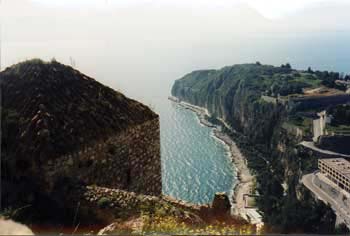 |
|||||||||||||||
|
|||||||||||||||
